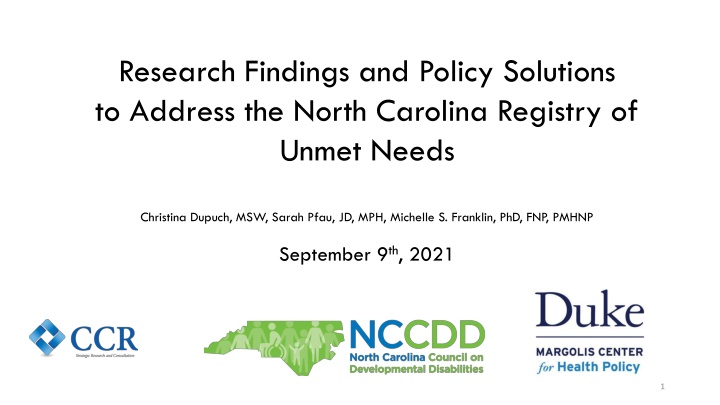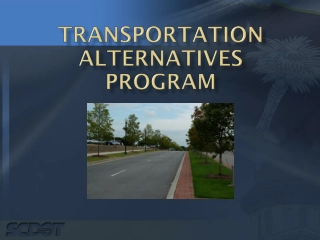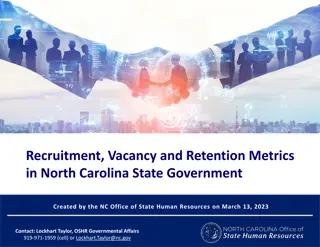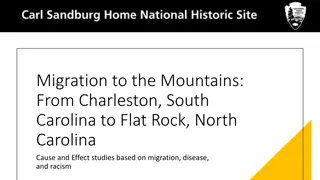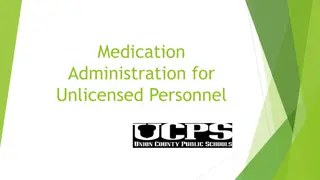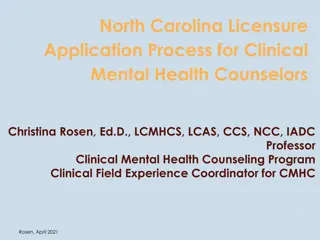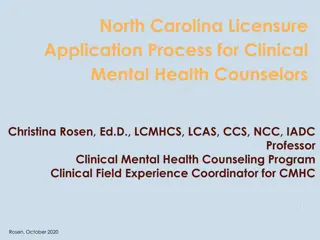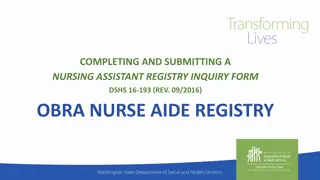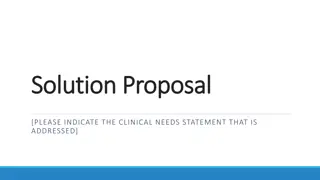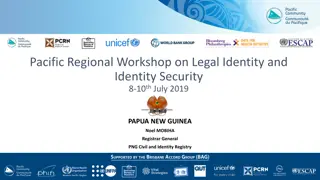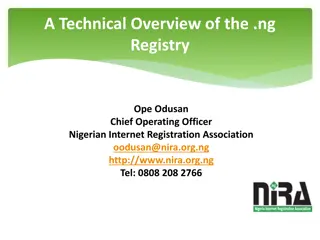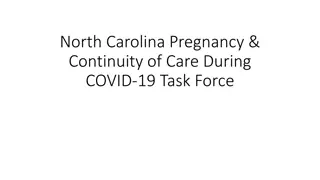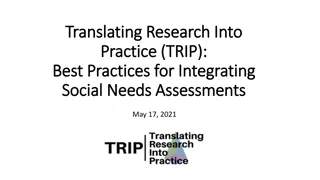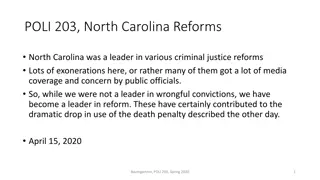Addressing North Carolina Registry of Unmet Needs
This research report presents findings and policy solutions for the North Carolina Registry of Unmet Needs. It covers the investigation of processes, funding, and strategies to meet the needs of individuals in the state. The report also outlines recommendations for systemic improvements.
Download Presentation

Please find below an Image/Link to download the presentation.
The content on the website is provided AS IS for your information and personal use only. It may not be sold, licensed, or shared on other websites without obtaining consent from the author.If you encounter any issues during the download, it is possible that the publisher has removed the file from their server.
You are allowed to download the files provided on this website for personal or commercial use, subject to the condition that they are used lawfully. All files are the property of their respective owners.
The content on the website is provided AS IS for your information and personal use only. It may not be sold, licensed, or shared on other websites without obtaining consent from the author.
E N D
Presentation Transcript
Research Findings and Policy Solutions to Address the North Carolina Registry of Unmet Needs Christina Dupuch, MSW, Sarah Pfau, JD, MPH, Michelle S. Franklin, PhD, FNP, PMHNP September 9th, 2021 1
Todays Conversation Today s Conversation Opening Remarks & Introductions Scope of Work: NCCDD Registry of Unmet Needs Project LME/MCO Survey & Findings NC Stakeholder Listening Sessions: Considerations/Concerns /Strategies State Interviews & Findings Policy Recommendations Questions/Comments Next Steps 3
NCCDD Project Description NCCDD Project Description Investigate and report on the current processes and administration of the waivers and I/DD state-funded services by the State and LME/MCOs, Explore the needs of individuals on the RUN and the processes for determining such needs, Explore the funding and processes for individuals on the RUN who are provided new waivers or services, and any processes for individuals on the RUN experiencing emergency needs. Investigate and report on historical funding of Medicaid waivers, particularly new waiver funding for those on the RUN from 2010 to the present. Investigate, evaluate, and report on national and state strategies to reduce the number of people on the RUN and to meet their needs, 4
NCCDD Project Description NCCDD Project Description Investigate, evaluate, and report on systemic efforts that may impact the RUN, including Medicaid Transformation; state Olmstead planning; and legislative, judicial, and agency efforts. Facilitate four or more Conversations with the Council on the potential strategies to impact the RUN with: State Medicaid, DMH/DD/SAS, and agency leaders; Advocacy groups, advocates, self-advocates, and families; LME/MCOs; and Designated stakeholders. Connect the Council Executive Director, staff, and Council Members with key agency and stakeholder leaders. 5
LME/MCO Surveys LME/MCO Surveys Sandhills Trillium Vaya Alliance Cardinal Eastpoint Partners 6
LME/MCO Survey Findings LME/MCO Survey Findings RUNs among all seven LME/MCOs January 2021 = 15,187 December 2019 = 14,295 6% increase Dec 2019 to Jan. 2021 Average number per region = 2,169 Smallest waiting list: Eastpointe = 597 Largest waiting list: Alliance Health = 3996 Wait times NC RUN wait time: 5 - 15 years Wait time varies by slot type & by county Slot Assignments First come, first served basis Then on per capita basis within catchment area counties 8
LME/MCO Survey Findings LME/MCO Survey Findings The RUN is not managed in a standardized way LME/MCOs neither manage their RUN lists nor communicate with RUN enrollees consistently. Some LME/MCOs cannot report demographic or other trends within their RUN. Other LME/MCOs monitor RUN enrollees age, race, ethnicity, and county of residence. 3 of 7 LME/MCOs do not track the race and ethnicity of individuals who are on the RUN. 1 LME/MCO collects the demographic information on applications but does not analyze or report it. 3 LME/MCOs analyze the race and ethnicity of their RUN population. 1 LME/MCO, Vaya Health, provided its RUN race and ethnicity data with survey responses. 9
LME/MCO RUN Population Race & Ethnicity LME/MCO RUN Population Race & Ethnicity Statewide collection and analysis of these data across all LME/MCOs are warranted to ensure that systemic biases are not posing barriers to access for any race or ethnicity. 10
LME/MCOs that collect and analyze their RUN data implement the following strategies to better serve their members: In-lieu-of Medicaid services and definitions to assist beneficiaries while they are on the RUN State-funded services and definitions to assist beneficiaries while they are on the RUN In-reach efforts Children with complex needs services Behavioral health and substance use disorder services Provider contracting and quality management activities Increased care coordinators efforts to assist with educating and linking members to the RUN or services available Some LME/MCOs have care coordinators dedicated to RUN enrollees Engage community-based resources to connect individuals on the RUN with services that are available Some LME/MCOs assess the service needs of individuals on the RUN as often as quarterly 11
LME/MCO Policy Recommendations LME/MCO Policy Recommendations 1) Greater regulation of the RUN process either within the Waiver (which has the force and effect of administrative rule pursuant to NC Statutes) or within the LME/MCO-DHHS contracts; 2) Executive Leadership meetings to facilitate standardized RUN oversight and management; 3) NC General Assembly appropriations for additional Innovations Waiver slots; 4) NC General Assembly and Centers of Medicaid/Medicare Services (CMS) authorization and appropriations for broader Medicaid supports, including medical and non-medical drivers of health, and in lieu of services for individuals on the RUN; 5) A Statewide, DHHS-operated RUN database to increase administrative efficiency and accuracy and to centralize the oversight of slots; 12
LME/MCO Policy Recommendations LME/MCO Policy Recommendations 6) Authorization to fill vacant slots in real time versus at the beginning of a new budget year; 7) Consumer and family education about the RUN and the Innovations Waiver and assistance with referrals to other community living and support services available; 8) More staff designated to work with RUN applicants and to evaluate applicants for the Social Determinants of Health (Food Insecurities, Transportation, Housing and Personal Violence) 9) A meaningful feedback loop between each LME/MCO (or the State, if operations become centralized) and each individual on the RUN to include annually, but preferably quarterly, communication regarding RUN status. 13
NC Stakeholder NC Stakeholder Listening Sessions Listening Sessions 14
IDD Stakeholder Conversations IDD Stakeholder Conversations NCCDD Members State CFAC DD Consortium Olmstead: Community Capacity Committee NC Providers Council IDD Committee NC Innovations Action Waiver Team Money Follows the Person Stakeholder Committee Cardinal Innovations Healthcare IDD Stakeholder Group 15
Purpose Identify effective strategies for improving access to IDD Waiver Slots by examining how states have: Designed and adapted their IDD waiver systems Shortened or eliminated their waiting lists Addressed unmet needs and inequities State Interviews State Interviews States Interviewed North Carolina Georgia Louisiana Maryland Tennessee Texas Washington Wisconsin 17
State Survey Results State Survey Results Average (range) # of States Analyzed Outcome North Carolina 3.6 (1-10) # of IDD Waivers 1 8 19,814 (10k-60k) # of Waiver Slots 13,138 6 27,155 (0-159k) # on Waiting List ~15,000 8 9.1 (0-15) Waiting List Time (Years) ~10 5 21
States with Shortened or States with Shortened or Eliminated Waiting Lists Eliminated Waiting Lists Louisiana 4 waivers currently; applying for one, 4-tiered waiver 2015: 40,000 waiting (10-14 years) 2021: now 13,200 waiting Key investment Wisconsin Statewide managed care with 4 statewide plans Robust benefits No waiting list as of Feb. 2021 Entitlement 22
State Strategies State Strategies for Reducing Or Eliminating Waiting Lists for Reducing Or Eliminating Waiting Lists Shared Strategies (2 or more states) Advocate for recurring, annual State legislative appropriations Maintain a rapport with a legislative Champion Maximize access to information and non-waiver services Tier waivers by service needs Unique Strategies Use statutorily dedicated funding (LA) Use grassroots advocacy to make Waiver slots an entitlement under managed care (WI) Train and fund Cultural Brokers to prevent or address systemic bias (MD) Coordinate with other payors in the system (GA) Make a documentary film to feature waiting list stories (GA) 23
Conclusions Conclusions 24
Policy Recommendations for Policy Recommendations for The North Carolina Innovations Waiver The North Carolina Innovations Waiver Increase the number of Waiver slots so more individuals with IDD will be fully included, respected, valued, and supported in their communities. Increase workforce capacity and wages to ensure adequate support for existing and new Waiver slots. Centralize the Registry of Unmet Needs database within NC DHHS to ensure accurate data and timely and periodic (quarterly) notifications to beneficiaries on the RUN. Offer an online portal via NC DHHS (or consider amending the Enrollment Broker contract) for beneficiaries to read about, self-refer, and apply for the RUN. Institute and centralize a RUN enrollment telephone line. Collaborate with the North Carolina Institute of Medicine (NCIOM) on a year-long Task Force and final report that would yield recommendations to the North Carolina General Assembly. The task force could include representatives from the LME/MCOs (future Tailored Plans), the State Medicaid agency, consumers and their families, Disability Rights North Carolina, care management agencies, and vendors who might have a role in State operations. Develop educational content for potentially eligible individuals and consider Limited English Proficiency needs and outreach strategies for Historically Marginalized Populations within both urban and rural communities. 25
Policy Recommendations for Policy Recommendations for The North Carolina Innovations Waiver The North Carolina Innovations Waiver Work with stakeholders who can lobby to get the North Carolina General Assembly to support new slots annually with recurring funding. Institute annual reassessments of individuals on the RUN to ensure that their service needs are accurately documented and to facilitate any care management that may help them find non-Waiver services for which they are eligible. Expand the scope of data collected from RUN applicants to track the number of individuals on the RUN who are using one or more other services each month, and the service lines that they are using. Consider moving North Carolina away from a first come, first served RUN model and shifting to a needs- based placement with tiered enrollment and annual Innovations Waiver slot budget levels like those proposed in the 2021 Session Senate Budget bill. It could be helpful for LME/MCOs (future Tailored Plans) to track the numbers of individuals on the RUN who are receiving one or more other services per month. Those data, in addition to initial and periodic assessments, could inform the critical levels of service need on the RUN and determine how the list could be more strategically managed. 26
Questions/Comments: Questions/Comments: Please send comments or suggestions by Friday September 17 Please send comments or suggestions by Friday September 17th th to: to: info@nccdd.org info@nccdd.org Next Steps Next Steps 27
Thank you for the opportunity to assist the NCCDD in discovering the ways to move the system forward based on the strengths & challenges of ALL North Carolinians. It has been our pleasure to serve you. 28
